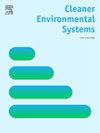Exploring the use of a machine assisted goal and scope in a life cycle studies to understand stakeholder interest and priorities
IF 4.9
Q2 ENGINEERING, ENVIRONMENTAL
引用次数: 0
Abstract
The Goal and scope are essential phases within a life cycle study as they lay the foundation for the subsequent inventory modelling, impact assessment, and interpretation of results. Stakeholder engagement is critical throughout life cycle studies. Addressing diverse stakeholder interests and priorities have so far relied on stakeholder-expert dialogues, which remain challenging, particularly in projects with numerous stakeholders leading to a broad range of environmental, social, and economic impact categories and subcategories. This study therefore introduces a machine-assisted goal and scope approach to manage large volume of stakeholder responses generated in stakeholder-expert dialogues. It is designed to complement current manual stakeholder engagement approaches with semi-automated computer assisted analysis that identifies stakeholder interests, concerns, and prioritises them. We apply Natural Language Processing (NLP) in the goal and scope phase to preprocess stakeholder response documents collected during a life cycle study within a larger EU project. After preprocessing, unsupervised clustering algorithms were used to determine stakeholders’ interests, concerns, and priorities. This innovative use of NLP and clustering was tested on a life cycle study of bioenergy value chains in Namibia (2021–2024). The approach successfully analysed stakeholder responses and identified key impact categories and subcategories on which to focus the assessment. Compared to manual methods, the machine-assisted goal and scope phase improved the level of detail while maintaining the same time frame and resource constraints. The current study serves as a proof of concept and demonstrates how life cycle studies can benefit from a machine-assisted goal and scope approach.
在生命周期研究中探索机器辅助目标和范围的使用,以了解利益相关者的利益和优先事项
目标和范围是生命周期研究的基本阶段,因为它们为随后的清单建模、影响评估和结果解释奠定了基础。利益相关者的参与在整个生命周期研究中至关重要。到目前为止,解决不同利益相关者的利益和优先事项依赖于利益相关者与专家的对话,这仍然具有挑战性,特别是在具有众多利益相关者的项目中,导致广泛的环境、社会和经济影响类别和子类别。因此,本研究引入了一种机器辅助的目标和范围方法来管理在利益相关者-专家对话中产生的大量利益相关者响应。它的目的是用半自动的计算机辅助分析来补充当前手工的涉众参与方法,识别涉众的兴趣、关注点,并对它们进行优先级排序。我们在目标和范围阶段应用自然语言处理(NLP)来预处理在更大的欧盟项目的生命周期研究期间收集的利益相关者响应文件。预处理后,使用无监督聚类算法确定利益相关者的兴趣、关注点和优先级。在纳米比亚生物能源价值链的生命周期研究(2021-2024)中,对NLP和聚类的这种创新使用进行了测试。该方法成功地分析了利益相关者的反应,并确定了重点评估的关键影响类别和子类别。与人工方法相比,机器辅助的目标和范围阶段在保持相同的时间框架和资源约束的同时提高了细节水平。目前的研究作为概念的证明,并展示了生命周期研究如何从机器辅助的目标和范围方法中受益。
本文章由计算机程序翻译,如有差异,请以英文原文为准。
求助全文
约1分钟内获得全文
求助全文
来源期刊

Cleaner Environmental Systems
Environmental Science-Environmental Science (miscellaneous)
CiteScore
7.80
自引率
0.00%
发文量
32
审稿时长
52 days
 求助内容:
求助内容: 应助结果提醒方式:
应助结果提醒方式:


